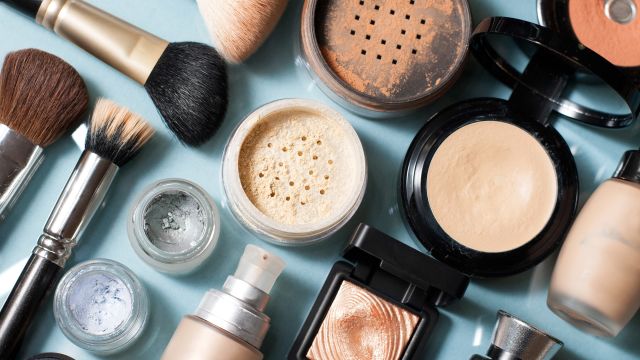Updated on March 5, 2025.
Have you ever wondered what goes into your lotion, or what makes up your makeup? Depending on the brands you buy, personal care products can contain a long list of chemical ingredients. Many have been used in these items for decades—and over time, their safety has come into question.
Here’s what to know about three of these substances—parabens, formaldehyde, and talc—and whether they might pose long-term health risks.
Parabens
Parabens are common chemicals that help preserve makeup, moisturizers, shaving products, and sunscreens, among many other personal care products. They're intended to keep you safe by preventing the growth of harmful bacteria and mold. They're absorbed through your skin. Many parabens are also found in packaged foods and are consumed. Parabens are so common, studies estimate most people in the United States have them in their system.
If you buy products with parabens, it’s important to read labels and use only as directed. They may be listed under a variety of names, typically ending in ‘-paraben,’ such as:
- Methylparaben
- Propylparaben
- Butylparaben
- Ethylparaben
Parabens have been linked to the disruption of hormones in some research. They may have a weak estrogen-like effect. Estrogen is a hormone involved in female reproduction. High levels of it might play a role in breast and ovarian cancer development. Limited studies have tied parabens to the possibility of reproductive issues, as well.
Despite these associations, studies haven’t found a direct cause-and-effect between parabens and any health problems. In other words, there isn’t enough evidence to show these chemicals pose a threat to human health.
What’s more, the U.S. Food and Drug Administration (FDA) has not found parabens to be harmful specifically in cosmetics. The FDA doesn’t regulate cosmetic preservatives before they hit the market, and manufacturers themselves usually perform safety testing. However, the FDA does review any studies published on preservatives. If researchers decide a substance is too risky, the FDA will notify the public. So far, parabens haven’t raised FDA concern.
Formaldehyde
Formaldehyde is a preservative sometimes found in cosmetics, baby lotions, and hair products. It’s a known cancer-causing agent, according to studies involving people who’ve had large exposures. The amount in U.S. products is small enough to be considered safe, but it can cause allergic skin reactions on contact for some people.
Certain hair products like hair-smoothers may contain methylene glycol, which releases formaldehyde into the air when heated. Again, the FDA doesn’t approve hair and cosmetic products before they hit the market. But the organization does notify the public and issue warnings to companies if products could harm consumers. The FDA doesn’t limit formaldehyde use in cosmetics, but it has issued warnings about methylene glycol.
Since methylene glycol gets heated at the salon—during blow drying, curling, straightening, etc.—customers and salon workers may breathe in the formaldehyde it releases. That level of exposure puts them at risk for:
- Neurological problems like headaches and dizziness
- Vision problems
- Breathing difficulties or chest pain
- Nausea, vomiting
- Allergic reactions
Inhaled formaldehyde has also been associated with nose and lung cancer, according to the U.S. Occupational Safety and Health Administration (OSHA), and leukemia, according to the American Cancer Society (ACS).
If you’re concerned about inhaling formaldehyde or methylene glycol at home, the FDA recommends checking product labels before making purchases. Also look for formalin, a similar compound, and watch out for these formaldehyde-releasing ingredients:
- DMDM hydantoin
- Imidazolidinyl urea
- Diazolidinyl urea
- Quaternium-15
- Bronopol (2-bromo-2-nitropropane-1,3-diol )
- 5-Bromo-5-nitro-1,3-dioxane
- Hydroxymethylglycinate
To avoid an exposure at the hairdresser, ask them to skip hair-smoothers. You can call ahead to confirm products are formaldehyde-free as well.
Talc
Talc is a mineral found in some baby powders, dry shampoos, foundations, and makeup powders. Because it absorbs moisture, it’s often used in products for oily skin and hair types.
Some talc powders contain asbestos in its natural form. Asbestos is a carcinogen, or a cancer-causing substance. If talc that contains asbestos is put directly onto the genital area, or onto a sanitary napkin, it could potentially raise your risk of ovarian cancer.
However, the FDA doesn’t allow cosmetic talc to contain asbestos. From 2009 to 2010, the organization commissioned a study to determine whether the substance had been successfully removed from U.S. cosmetics. Out of the 34 products surveyed, the researchers found no asbestos fibers.
Despite these results, the FDA doesn’t state that products with talc are free of asbestos. In fact, as of December 2024, the organization is attempting to establish standardized testing methods for asbestos in these items.
A number of researchers have investigated whether talc products pose a risk even after asbestos removal. Some studies suggest there could still be a link between ovarian cancer and talc, but results are mixed. If you’re concerned, the ACS recommends limiting your use of talc-based products until more information is available.







